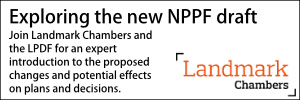Crematorium change of use and the Green Belt
- Details
A crematorium change of use in the Green Belt was recently found by a planning inspector not to be inappropriate development. Jonathan Clay explains why.
The Secretary of State’s inspector, Rachael Pipkin, has granted planning permission on appeal for a crematorium extension to an existing cemetery chapel in the Green Belt in Sevenoaks District [1], Kent.
The appellant successfully argued that the development was not inappropriate development as an extension to an existing building that was not a disproportionate addition over and above the size of the original existing chapel. This brought it within the exception in 145(c) of the Framework.
Sevenoaks had argued that while the building was “not inappropriate development in the Green Belt” the change of use to add the crematorium use had to be considered and, they reasoned, it did not fall within any of the exceptions in 145 or 146 of the Framework,
The Inspector noted that the council sought to rely on the Timmins v Gedling Borough Council [2] judgment as a reason why paragraph 145 c) does not embrace a material change of use of buildings, noting that the inclusion of the words ‘or a change of use’ in paragraph 145 b) was introduced after that judgment, and only to that particular criterion of paragraph 145 to explicitly allow material changes of use.
The Inspector had been referred by the appellant to David Elvin QC’s judgement in Bromley LBC v SSCLG [3], in regard to the application of what would now be paragraph 145 g) of the Framework, where Bromley Council had unsuccessfully taken a similar point when permission had been granted under the 2012 NPPF in relation to residential development under the “limited infill” exception. In the Bromley case it was held that the fact that permission for a new building may also involve a material change of use does not mean that it ceases to be “not inappropriate” development. Noting the council’s position that it would not be common sense to allow a building to be extended and for its use to change, she nevertheless, followed the judgment in the Bromley case; that it is “unnecessary to gloss” what are now paragraph 145 exceptions.
More fundamentally, she found that none of the cases to which she had been referred directly relate to paragraph 145 c) or its predecessor, paragraph 89 c), in the 2012 Framework. Acknowledging the policy objective of the Framework in respect of Green Belt which seeks to prevent urban sprawl or encroachment into the countryside. In the absence of any specification of the use under paragraph 145 c) which must be applied in accordance with the specific objectives of the policy and within its own terms, she concluded that the proposed extension, irrespective of its use, would, due to its not being disproportionate, be not inappropriate development.
Finally, she reasoned, as the effect of the development on openness is not expressly stated as a determinative factor in gauging inappropriateness under paragraph 145 c), there is no requirement to assess the impact of the development on the openness of the Green Belt.
In any event, she reasoned that if the scheme should be considered under paragraph 146, the limited effect of the development on intensity of use of the site and the physical impacts would all be contained within the proposed extension with only the chimney providing any indication of this activity on the site and the emissions from the chimney, being regulated so as not to cause harm to the area meant that she was not persuaded that the proposed use would not meet the requirements of paragraph 146(e) which relates to material changes of use.
The case illustrates the approach being taken by the Planning Inspectorate where the individual exceptions to the rule against new buildings in the Green Belt are in play. It is a practical and pragmatic analysis of the operation of the exceptions which allows limited development to proceed in the Green Belt within the narrow exceptions set out in 145 and 146 of the Framework.
The appeal also provides an interesting, if limited precedent in the form of a further change of use to add to cemeteries and sports facilities which, because of absence of harm, can be included in those uses which may be acceptable in the Green Belt.
Jonathan Clay of Cornerstone Barristers Instructed by John Escott of RE Planning, he acted for the Appellant.
Ruchi Parekh, also of Cornerstone Barristers, appeared for Sevenoaks District Council, instructed by the Head of Legal Services.
[1] Appeal Ref: APP/G2245/W/19/3243177 Bluebell Cemetery, Watercroft Woods, Old London Road, Badgers Mount TN14 7AE. Inspector : Rachael Pipkin BA (Hons) MPhil MRTPI 27 January 2021
[2] R (Timmins) v Gedling Borough Council [2015] PTSR 837
[3] Bromley LBC v SSCLG [2016] EWHC 595
Sponsored articles
Walker Morris supports Tower Hamlets Council in first known Remediation Contribution Order application issued by local authority
Unlocking legal talent
Principal Lawyer - Planning, Property & Contract
Lawyer (Planning and Regulatory)
Senior Lawyer - Planning, Property & Contracts Team
Contracts Lawyer
Legal Director - Government and Public Sector
Locums
Poll








































